Strength training: Is it the newest edge for golf?
05/01/2000
Furci Home / Fitness Channel / Bullz-Eye Home
ALSO: Don't miss Mike's article on preventing injuries and targeting the specific muscles used while playing golf.
Some golfers will spend hundreds of dollars on a driver. They'll spend hundreds on lessons. Some will spend tens of thousands to be able to play at the most prestigious country clubs. Many will spend hundreds on expensive golf balls. But, the average golfer will not spend a dime on improving the most valuable asset to his game: his body. I can't imagine buying a $1200 set of clubs, and not doing some sort of conditioning to ensure I could use them to their full capacity. The average golfer's conditioning program consists of a couple of practice swings, maybe a few twists to loosen up, and then it's off to the races. Think about it, what's more important, a graphite shaft, or a strong and healthy lower back?
Many golfers I talk with think that injuries like low back pain and shoulder problems are just a part of the game. What if I told you that a strength and conditioning program can cure most of these ailments, and can dramatically improve the risk of experiencing future problems? In addition, a proper program can dramatically improve your game. Many pros, including Nancy Lopez will tell you that their strength and conditioning programs helped their game, and it also saved their careers.
Many top professionals are seeing the benefits of getting into, and staying in top physical condition. Professional golfers are finally looking at themselves for what they are...athletes. That's right, golfers are athletes. To be successful in what many consider to be a game of frustration and skill, one need's strength, endurance, balance, coordination, finesse, and timing. These aspects of the game cannot be found in a pro shop. Most people focus on the latest ball or most expensive club to be competitive. They do not look toward their bodies for the answer. These same people with the finest equipment money can buy, can't walk up a flight of stairs without gasping for air.
Being out of shape is a common problem. If you're like most people, not just golfers, chances are you don't exercise at all. It's important that you seek professional guidance when starting a training program. Proper form and exercise-choice are imperative. A qualified personal trainer can help ensure that you get started on the right foot. (Be cautious of the personal trainer you select. There are a lot of quacks out there. Make sure to get referrals of other athletes who have used their services.)
Working out at home isn't a great idea. There are too many distractions at home, and the drop out rate for home exercise is 9 out of 10. A gym, on the other hand, is a motivating environment where qualified professionals are available to assist you. Make a commitment to yourself, join a gym, and use a trainer to get you started.
A properly trained professional can help anyone at any age and fitness level. Don't think because your 40, 50, 60, or even 70, it's too late. It's not. A Strength and Conditioning program, at any level, should consist of 3 components: Strength training, Flexibility, and Cardiovascular conditioning.
"I don't want to lift because I'll get bulky and it will screw up my swing." Get a grip! (No pun intended) You're out of shape and weak. Face the facts. You're not getting any younger. You're going to continue to get weaker and further out of shape.
I understand the concern of screwing up your swing. Many of you have spent hundreds, even thousands on improving your swing. YOU WILL NOT SCREW UP YOUR GAME. The amount of time, energy, motivation, supplementation, and sacrifice it takes to build the amount of muscle that would ruin your swing is staggering. You will, however, increase your metabolism, get a leaner physique, sleep better, increase your ability to concentrate, improve your immune function, and live longer.(Not bad for a couple of hours a week in the gym) From a golfers point of view, you can add 10-20 yards to your drive, take 3-10 points off your handicap, and reduce your risk of injury. There isn't a pill available that any doctor could prescribe that gives you the positive affects a strength and conditioning program can. You can't afford not to get going on a program.
A lot of the gains you will make through strength training will be neurological. This is by far the most important factor for a golfer seeking to better his game. As we all know, over-powering the ball is probably the most common problem among amateurs. With a proper conditioning program, you will actually make adaptations that will facilitate your ability to fire more neurons in the muscle. This in turn will help you achieve a higher peak force in your swing.
What does this mean for your game? You will be able to generate a faster club head speed with less effort. These results are not only backed by empirical data I've gathered over the years, but by science.
You should now be completely inspired and excited about getting in shape and starting on a conditioning program for the upcoming season. Keep in mind that when you start a strength and conditioning program, a trainer should take into consideration a person's age, fitness level, and injury history. A program should be tailored to your individual needs. In addition, a complete physical is recommended to make sure you don't have any underlying health problems. The following is an example of a basic program a beginner might use. If done properly, not only will you improve your game, but your health as well.
Warm up
To get the body ready to train, do a walk for ten minutes on the treadmill, or ride for ten minutes on a bike. Do your warm up at a moderate pace. Save your aerobic training for later. For the following exercises, perform two sets of 8 to 12 repetitions each. If you can perform two sets of twelve with a particular weight, it's time to increase the amount your lifting. If you can't do at least eight repetitions the weight is too heavy.
Leg Press
Major muscles worked: Quadriceps, Hamstrings, and Glutes. (legs and butt)
- Adjust the backrest to personal preference.
- Place your feet in the center of the platform, approximately shoulder width apart.

- Lower the weight down to a 90- degree angle in the knee joint.
- Heels must remain on the platform throughout the movement.
- Keep hips pressed firmly against the back of the pad throughout the movement. Do not allow your pelvic girdle to roll under at the bottom of the movement.
- Slowly push the weight back to the starting position.

Single Leg Squats
Muscles involved: Quadriceps, Hamstrings, and Glutes.
This movement is especially good for developing balance and
the stabilizing muscles of the legs and hips.
- Stand approximately three and a half feet in front of a flat bench.
- Put the top of one foot on the top of the bench.
- Looking straight ahead with your chest up.
- As you lower your body, throw your hips back until your upper thigh is parallel to the floor.
- Slowly push yourself back to the starting position.
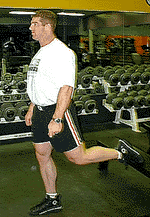 |
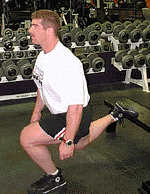 |
Flat Dumbbell Press
Muscles involved: Pectoral, Anterior deltoid, and Tricep. (Chest, shoulders, and back of arms)
- Lie back on the bench and position feet flat on the floor.
- Grasp the dumbbells with a closed grip, palms facing forward.
- Press the dumbbells over your chest until your arms are fully extended.
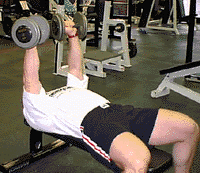
- Lower the dumbbells, (controlled movement) until they are just above your chest.
- Slowly push dumbbells back to the starting position.

Seated Cable Rows
Muscles involved: Back, Stabilizing muscles of the shoulder, and the Biceps.
- Assume a seated position with your torso perpendicular to the floor.
- Sit tall with your chest up and your knee's slightly bent.
- Grasp a V-bar with a closed grip and elbows fully extended.

- Keep your body erect and stationary.
- Do not lean forward or backward at any portion of the movement.
- Under control pull the bar to your upper abdomen keeping your elbows next to your ribs.
- Slowly allow the bar to move back to the starting position
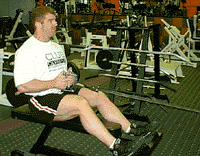
Dumbbell Lateral Raises
Muscles involved: Shoulders
- Stand erect with the dumbbells hanging at your sides.
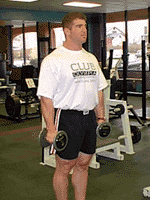
- Lift the dumbbells (controlled movement) with your palms facing down until your arms are parallel to the floor.
- Allow the dumbbells to slowly return to the starting position

Crunch
Major muscles involved: Abdominals
- Lie face up with your calves and ankles on a bench. Hips and knees should form 90 -degree angles.
- Fold your arms across your chest or abdomen with your chin tucked to your chest.

- Curl your upper body toward your thighs until your upper back is off the floor.
- Slowly lower your upper back to the floor.
- Do not bounce or jerk at any part of the movement.
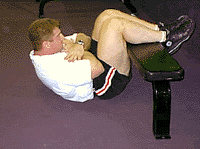
Flexibility
The jury is still out when it comes to stretching. Does it help prevent injuries? Most experts agree that it does. The question arises as to when the stretching should be done. Many studies have shown that stretching before an activity will cause a reduction in peak force. What does that mean? In layman's terms, repeated stretching before you golf can cause a reduction in how far you hit the ball. Obviously this is not what you want. Therefore, many experts, including myself, believe that the best time to stretch is after your activity. When it comes time to play golf ,I recommend that my clients do certain warm up exercises with very little stretching done intermittently.
Stretching
Spinal Twist
Muscles affected: Spinal erectors, Internal and external
obliques. (Lower back)
- Sit with your legs straight and your upper body
almost vertical. - Place the back of your left elbow on the back of your right knee.
- Place your right palm on the floor directly behind (Figure 13) your hips.
- Push your right knee to the left with your left elbow while turning your shoulders and head to the right as far as possible.
- Hold for ten seconds, relax, then hold for ten more.
- Repeat with the left leg.
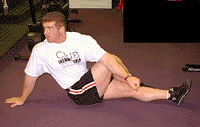
Supine Knee Flex
Muscles affected: Gluteus maximus and Hamstrings.
- Lie on your back with your legs straight.
- Flex your right leg, and pull your knee toward your chest with both hands. (Figure 14)
- Keep your shoulders back and leg on the ground throughout the movement.
- Hold for a count of ten, twice with each leg.

Side Bend With Bent Arm
- Stand with your feet slightly wider than shoulder width.
- Raise your right elbow above your head and grasp it with your left hand.
- Pull your elbow behind your head keeping your (Figure 15) arm bent.
- Without bending your knees, lean to the left as far as possible.
- Hold for a count of ten, twice on each side.
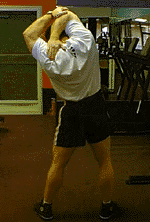
Cardiovascular Training
When starting out, walk on the treadmill for 15 minutes at a pace that will put you at around 60 percent of your maximum heart rate. The formula for figuring this out for yourself is 220 minus your age multiplied by .6. A qualified trainer at your gym should be able to help you with finding a starting point. Then, over time ,depending upon one's age and fitness level, you should gradually increase the intensity of your cardio training up to 80 percent of your max heart rate. You also want to gradually increase the time to 30 minutes.
Increasing the intensity and time you do cardio will increase your fitness level. With an increased fitness level you'll be able to play your game with less fatigue, allowing you to play better. Who knows, you may end up saving yourself some money from lost balls and clubs thrown across the fairway. Have a healthy and successful golf season!
Questions or comments? Send them to mike@bullz-eye.com.
You can follow us on Twitter and Facebook for content updates. Also, sign up for our email list for weekly updates and check us out on Google+ as well.













